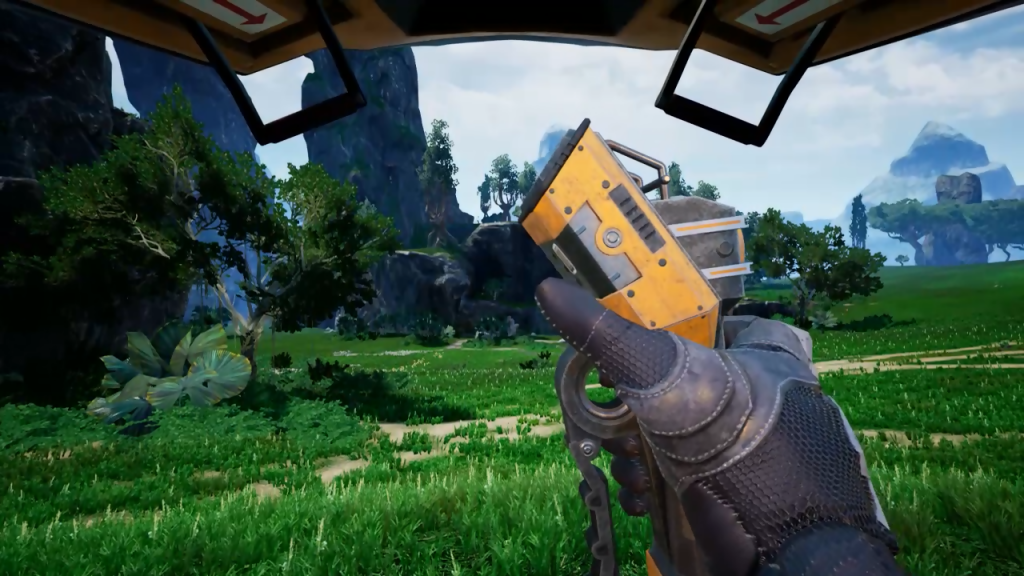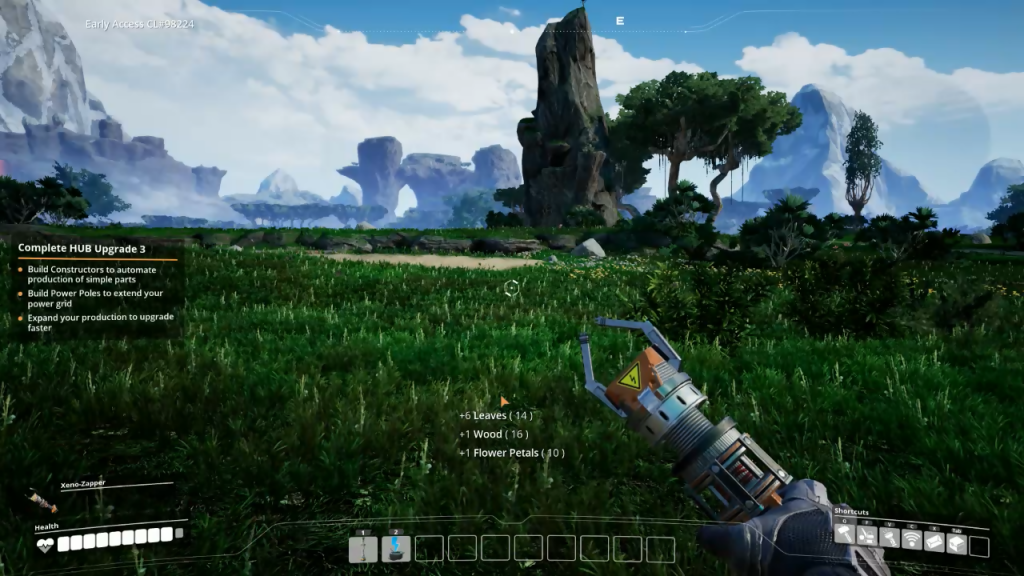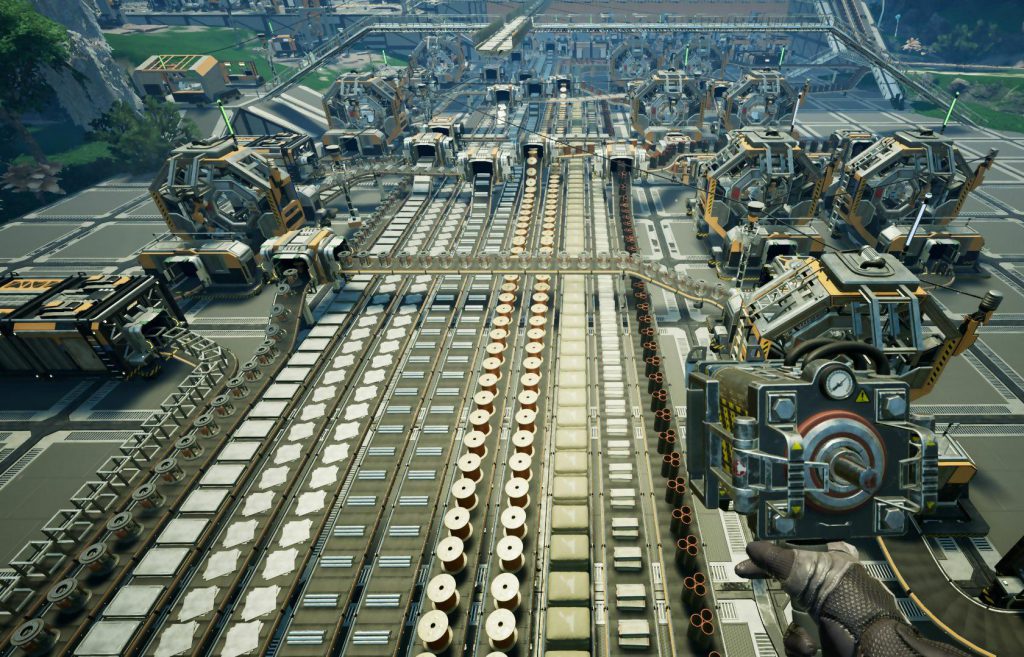
Satisfactory is the factory building simulator concocted by the gents that brought us Goat Simulator….of all games. The gameplay loop is simple enough: mine valuable natural resources to build machines that help you mine for natural resources so you can design factories that expedite the mining of resources, ad infinitum. The joy is in the planning and exploration as you traverse lush alien planets in search of natural mineral deposits to exploit, developing small mining operations into enormous, mall-sized industrial machines to pump precious rocks and things from beneath the surface.

There isn’t much explanation or narrative for what’s going on. A short animation plays at the start of the game offering a bit of information about who you are and what you do. You work for FICSIT, a massive, interplanetary corporation that apparently sends its employees – you – to distant, resource-rich alien planets to pump them empty of their minerals. You get the feeling that the people that pay your salary might just be the bad guys and you’re not much more than a cog in their well-oiled, planet-eating industrial machine. After landing with a dull thud on the planet’s surface (there’s a currently a choice of three planets with different biomes which you select before beginning a session), a brief tutorial offers a bit of guidance on the main mechanics of the game before leaving you to your own devices.

Some elements of survival gameplay exist in Satisfactory, though they’re clearly secondary to the main mechanics of resource mining and machine building. Combat, in particular, feels floaty, with your hits lacking weight. The lack of visual and audio feedback makes battles unsatisfying and often difficult to determine if your attacks hit their mark. Aggressive creatures are clearly a balancing mechanic, acting as deterrence for new players hoping to immediately start farming the more valuable minerals from the get-go. Hopefully, plans are in the works to improve combat overall.
Descriptions of Satisfactory tend to reduce the game to a mere 3D re-imagining of Factorio. You spend much of the game either mining for resources or slapping together combinations of different processing and resource extracting machines to help you accelerate the mining of resources. Such comparisons, while warranted, are a bit unfair to Satisfactory. The additional dimension of play, the ability to add levels and height to your buildings, adds a refreshing verticality to the planning and construction processes, yet another aspect that must be considered in the chase for ultimate efficiency. The first-person perspective also introduces a visual sense of enormousness, of the world and of your constructions, that is notably missing when played from the top-down perspective of Factorio. I still often find myself in awe at the sheer size of some of my creations, metallic monsters of conveyor belts, smelters, and automated transport robots that consume massive swathes of the planet’s surface.

The worlds you walk are gorgeously hand-crafted by Coffee Stain’s level designers, the team favoring carefully constructed environments to the generic creations that procedural generation algorithms tend to produce. This attention to detail can be found in the animations and texturing, as well, with a clean HUD and sharp, purposeful movements that communicate a polish and professionalism often missing in other early access titles. It certainly helps that the game, which runs on Unreal Engine 4, looks fantastic and runs smoothly.
The sandbox nature of Satisfactory makes it the kind of game that lends itself well to the share-everything Internet culture of Youtube and Twitch where talented individuals can showcase their planning and automation prowess to the world. This strategy worked for Minecraft – and, of course, Factorio – and Satisfactory seems to have been tailor-made to go down that route with built-in co-op play and the inherent potential for putting together some amazing factories several stories in height. The skybox is literally the limit. Even now in this early stage of development, players are sharing clips of some jaw-dropping technical achievements or proofs of efficient construction patterns. The community has already done some amazing things and it’s worth exploring the plethora of information available, if only just to sit mouth agape at some of the wonders born from the minds of others.
One unexpected side effect of making this game first-person is the issue of travel. Whereas in Factorio you only need to scroll your mouse to get from one side of the map to the other, attempting a similar feat in Satisfactory is guaranteed to be a significant investment of your time. You run at quite the brisk pace, but the utter size of the map is the challenge. This really becomes a problem a few hours in, after you’ve sunk your teeth into the game proper and begun putting together factories that are sometimes kilometers in length. Naturally, there are machines and transportation vehicles for automated ferrying of resources across long distances and even a jet pack to facilitate movement from floor-to-floor, but at some point, it feels like you can never move fast enough. I have my suspicions that this may not be entirely accidental; the slowness of movement certainly incentivizes co-op play, which is one of the primary selling points of Satisfactory. Having another person on your team can cut down travel and building time significantly.

Satisfactory is a game that encourages experimentation and exploration. The real beauty of the game is in the potential for combining these simple, straightforward components into complex and intricate operations, rewarding dedication and, most of all, patience. The patience to travel from one end of your factory to the other, or to test and test and test again different machine configurations to maximize potential output or to build looming artificial constructs that kiss the clouds. Most of us will never find the patience or have the imaginative capacity to push the game to its limits, but there’s still a fun and well fleshed-out game for regular players. Its early access status has not held it back one bit, and even now in this early stage of development, Satisfactory is an enjoyable, challenging game with a polish and completeness that belies its early access status.
>